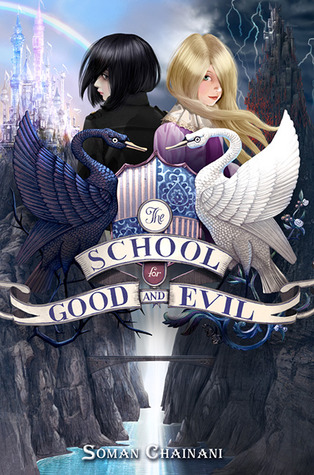Age Group: Middle-Grade
Genre: Fantasy
Pub Date: May 2013
Publisher: HarperCollins
I really wanted to love this book. Really. I saw in in a
bookshop and immediately fell in love with the cover and concept, and I was
over the moon when I saw it was available on NetGalley (thank you Netgalley and
HarperCollins for this copy). But I didn’t love this book. It was one of those
cases of “concept much better than execution”, and left me unimpressed in the
way it carried out its so-called messages.
The School
for Good and Evil follows Sophie and Agatha, and their entrance into the
title’s School for Good and Evil. The school is to train villains and heroes to
star in their own fairy-tales. Sophie is beautiful and seems like a perfect
princess, and Agatha is ugly and should be a witch. Shock horror, Sophie lands
in Evil, and Agatha lands in Good. The rest of the book follows them taking
part in classes, and trying to get to where they belong.
Let’s start with the good points: the plot and writing.
Despite the issues I had with the rest of the book, I found it an engaging
read, and well written. Chainani created a brilliant world, and despite the
parts I found confusing, I kept on wanting to keep reading on. He is also a
great writer, with enough description to make me see the world, witty one
liners, and lots of colourful and fun ideas.
Sadly, that is not enough to carry the book.
I found this book preachy and confusing. Whatever message it
was trying to give was erased a few chapters on by a contradicting idea. The
problem was that Chainani was dealing in extremes: pure good and pure evil,
making it very hard to see what was a statement and what was exaggeration. For
one, the Evers (“Good”) vanity was constantly criticised, which I find pretty
preachy, yes being overly vain is a bad thing, but wanting to indulge in
grooming and make up surely isn’t. Yet, there was no middle ground covered,
except when Agatha got a makeover to find out nothing had happened except she
was beautiful all along. This seemed to contradict his message that beauty is a
not essential to be good, and I would have preferred to have seen Agatha come
to terms with her looks that didn’t involve a fairy godmother. But was this all
exaggeration? Also it did not offer any
clear reasons for why people were good and evil. Were they just born like that?
I kept waiting for a reason for Sophie’s actions, but never got one.
That was another issue, the inconsistency in Sophie. Agatha I
liked, she was a well-rounded character, funny and flawed, and more importantly
I understood her. She wasn’t pure
good, but just good enough. Sophie was a mess. As I said before, I could not
understand anything she did. Everything seemed to boil down to an obsessive
need for Happy Ever After and vanity. Yet the only explanation was that she
read a lot of fairy tales and wanted to get out her hometown. One moment Sophie
was desperate to prove how good she was, the next she was the Ultimate Evil.
This made her a good plot device, but an awful character.
Was this a good middle-grade book? I probably wouldn’t give
it to an 11 year old. If you want to offer a good fairy-tale twist, there are
better things out there (check out Cathrynne Valance). I found it confusing and
I was way above the age-range. Nevertheless, it was exciting, fun, and
sometimes very clever, so I guess my summary of this is just as inconsistent as
the book itself.
Sum It Up: An erratic
story with a fairy-tale twist. It makes an interesting read, but don’t expect
anything too deep.
Rating: 5/10
*I received this copy from HarperCollins via NetGalley in exchange for an honest review*
*I received this copy from HarperCollins via NetGalley in exchange for an honest review*


No comments:
Post a Comment